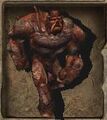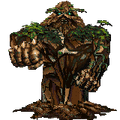Earth elementals were extremely strong elementals who rarely left their home plane.[7]
Description[]
These elementals had a vaguely humanoid shape,[6] with club-like arms made of jagged stone and a head made of both dirt and stone. Occasionally chunks of minerals, gems, or metals were set within their stony bodies.[8]
Their bodies typically moved at a slow, trodding pace.[8][6]
Personality[]
Earth elementals were not especially intelligent.[6] However, like all elementals, they instinctively resented any creature that conjured them from their home plane and bound them into its service.[8]
Biology[]
Being elementals, these creatures did not require any air, food, drink, or sleep to survive.[8]
Abilities[]
Earth elementals were capable of gliding through stone and dirt as though it were liquid,[8] but only if they were unworked and non-magical.[1] They were also capable of precisely pinpointing the location of nearby opponents, but only if they were standing on solid ground,[8] a type of vision that was known as tremorsense.[1]
Prior to the Time of Troubles, these elementals could not cross bodies of water. Thus they had to use their ability of burrowing through unworked earth to pass underneath the ground on which bodies of water stood.[6]
Bludgeoning, piercing, and slashing weaponry were all ineffective against earth elementals unless they were enchanted.[1] Prior to the Time of Troubles, they could only be damaged by weapons with a +2 enchantment or greater.[6]
Combat[]
Earth elementals would use their brute strength when fighting an opponent, slamming against them.[1][6] They were also considered to be living siege weapons, doing severe damage to objects and structures,[1] but especially those made of stone or earth.[6]
Society[]
Summoning[]
These elementals could be summoned to the Prime Material plane through use of the spells conjure elemental,[9] conjure earth elemental,[10] conjure lesser earth elemental,[11] elemental servant,[12] elemental summoning,[13] summon monster III, and summon monster VI.[14]
There were also magical items that could achieve this, such as a stone of controlling earth elementals, elemental gems.[15] the Elemental Scourge in Kossuth's House,[16] the laughing hare,[17] the Zakharan instrument rababah of the dao (but only if played by a bard or rawunin),[18] and the Tome of Twelve Seals.[19]
In terms of divine magic, specialty priests known as earthwalkers were granted the power to summon an earth elemental once per day or incredibly powerful ones once per tenday by their deity Grumbar. Upon reaching a certain level of skill, earthwalkers summoned their first earth elemental in a religious ceremony called Brotherhood of Earth.[20]
It was impossible to summon an earth elemental while in the phlogiston.[21]
Languages[]
Earth elementals rarely spoke, though when they did speak they used the Terran language.[7][1]
Relationships[]
Earth elementals were favored monsters of many deities within the Morndinsamman, acting as their divine servants. These deities included Berronar Truesilver, Clangeddin Silverbeard, Dumathoin. They were also servants of the exiled members of this pantheon, the duergar gods Deep Duerra and Laduguer.[22]
In the gnome pantheon, these elementals were favored monsters of the deities Baervan Wildwanderer, Callarduran Smoothhands, Flandal Steelskin, and Segojan Earthcaller. Outside of pantheons, individual deities that favored earth elementals as divine servants included Geb, Grumbar, Rillifane Rallathil, and Sheela Peryroyl.[22]
History[]
A svirfneblin cleric, Belwar Dissengulp, once summoned an earth elemental to protect his mining party from a drow ambush.[23]
Appendix[]
| This article is incomplete. You can help the Forgotten Realms Wiki by providing more information. |
Appearances[]
- Adventures
- Scourge of the Sword Coast
- Novels
- The Ring of Winter • The Council of Blades
- Referenced only
- Sentinelspire
- Comic Books
- Fools Rush In • Honor Among Thieves: The Feast of the Moon
- Video Games
- Baldur's Gate II: Shadows of Amn • Baldur's Gate II: Throne of Bhaal • Baldur's Gate III • Dungeon Hack • Icewind Dale • Neverwinter Nights • Neverwinter Nights: Tyrants of the Moonsea
- Board Games
- Temple of Elemental Evil Board Game
- Organized Play & Licensed Adventures
- Boltsmelter's Book
Gallery[]
External links[]
Disclaimer: The views expressed in the following links do not necessarily represent the views of the editors of this wiki, nor does any lore presented necessarily adhere to established canon.
 Earth Elemental article at the Baldur's Gate 3 Community Wiki, a community wiki for Baldur's Gate 3.
Earth Elemental article at the Baldur's Gate 3 Community Wiki, a community wiki for Baldur's Gate 3.
References[]
- ↑ 1.0 1.1 1.2 1.3 1.4 1.5 1.6 1.7 1.8 Mike Mearls, Jeremy Crawford, Christopher Perkins (2014-09-30). Monster Manual 5th edition. Edited by Scott Fitzgerald Gray. (Wizards of the Coast), p. 124. ISBN 978-0786965614.
- ↑ Mike Mearls, Greg Bilsland, Robert J. Schwalb (June 2010). Monster Manual 3 4th edition. Edited by Greg Bilsland, et al. (Wizards of the Coast), p. 81. ISBN 978-0-7869-5490-2.
- ↑ Skip Williams, Jonathan Tweet, Monte Cook (July 2003). Monster Manual v.3.5. (Wizards of the Coast), pp. 97–98. ISBN 0-7869-2893-X.
- ↑ James Wyatt (October 2001). Oriental Adventures (3rd edition). (Wizards of the Coast), p. 145. ISBN 0-7869-2015-7.
- ↑ Doug Stewart (June 1993). Monstrous Manual. (TSR, Inc), p. 99. ISBN 1-5607-6619-0.
- ↑ 6.0 6.1 6.2 6.3 6.4 6.5 6.6 6.7 Gary Gygax (December 1977). Monster Manual, 1st edition. (TSR, Inc), p. 38. ISBN 0-935696-00-8.
- ↑ 7.0 7.1 Skip Williams, Jonathan Tweet, Monte Cook (July 2003). Monster Manual v.3.5. (Wizards of the Coast), p. 98. ISBN 0-7869-2893-X.
- ↑ 8.0 8.1 8.2 8.3 8.4 8.5 Mike Mearls, Jeremy Crawford, Christopher Perkins (2014-09-30). Monster Manual 5th edition. Edited by Scott Fitzgerald Gray. (Wizards of the Coast), p. 123. ISBN 978-0786965614.
- ↑ Mike Mearls, Jeremy Crawford (2014). Player's Handbook 5th edition. (Wizards of the Coast), pp. 207–211, 225. ISBN 978-0-7869-6560-1.
- ↑ Richard Baker (1996). Player's Option: Spells & Magic. (TSR, Inc), p. 178. ISBN 0-7869-0394-5.
- ↑ Drew Karpyshyn et al (2000). Baldur's Gate II: Shadows of Amn Game Manual , link:[1]. (BioWare).
- ↑ Gary Gygax, David Cook, and François Marcela-Froideval (1985). Oriental Adventures. (TSR, Inc), p. 93. ISBN 0-8803-8099-3.
- ↑ Schlieker Design (2001). Baldur's Gate II: Throne of Bhaal Game Manual , link:[2]. (BioWare).
- ↑ Jonathan Tweet, Monte Cook, Skip Williams (July 2003). Player's Handbook v.3.5. (Wizards of the Coast), pp. 286–287. ISBN 0-7869-2886-7.
- ↑ Mike Mearls, Jeremy Crawford, Christopher Perkins, James Wyatt (2014). Dungeon Master's Guide 5th edition. (Wizards of the Coast), pp. 156, 167–168. ISBN 978-0786965622.
- ↑ Darrin Drader, Thomas M. Reid, Sean K. Reynolds, Wil Upchurch (June 2006). Mysteries of the Moonsea. Edited by John Thompson, Gary Sarli. (Wizards of the Coast), p. 120. ISBN 978-0-7869-3915-2.
- ↑ Mike Pondsmith, Jay Batista, Rick Swan, John Nephew, Deborah Christian (1988). Kara-Tur: The Eastern Realms (Volume II). (TSR, Inc), p. 125. ISBN 0-88038-608-8.
- ↑ Jeff Grubb (February 1993). “Sounds of Wonder & Delight”. In Roger E. Moore ed. Dragon #190 (TSR, Inc.), pp. 84–88.
- ↑ Jennell Jaquays (1988). The Savage Frontier. (TSR, Inc), p. 60. ISBN 0-88038-593-6.
- ↑ Julia Martin, Eric L. Boyd (March 1996). Faiths & Avatars. (TSR, Inc.), pp. 67–68. ISBN 978-0786903849.
- ↑ Jeff Grubb (August 1989). “Concordance of Arcane Space”. Spelljammer: AD&D Adventures in Space (TSR, Inc.), p. 82. ISBN 0-88038-762-9.
- ↑ 22.0 22.1 Sean K. Reynolds (2002-05-04). Deity Do's and Don'ts (Zipped PDF). Web Enhancement for Faiths and Pantheons. Wizards of the Coast. pp. 10–15. Archived from the original on 2016-11-01. Retrieved on 2018-09-08.
- ↑ R.A. Salvatore (September 1990). Homeland. (TSR, Inc.), p. ?. ISBN 0-1401-4372-6.










